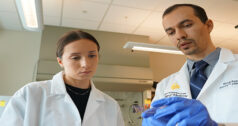
Breaking a bone can be traumatic for anyone, but the pain and anguish are amplified in kids. Treating fractures in pediatric patients with traditional metal orthopedic implants and having to remove them after the bones have healed adds another layer of anxiety to an already stressful experience and can even harm their still-developing bodies.
Researchers at the University of Central Florida (UCF) have addressed these concerns by developing implants made of bioabsorbable magnesium composites that are absorbed into the body. “Our team’s motivation stems from a collective expertise in biomaterials and metallurgy, which we’re using to tackle a significant clinical challenge,” said UCF biomedical engineer Mehdi Razavi, Ph.D. “Applying fundamental bioengineering principles to alleviate pain in pediatric patients and reduce healthcare costs is a tremendous opportunity.”
Zach Stinson, M.D., a pediatric orthopedic surgeon and sports medicine physician at Nemours Children’s Health contributed to Dr. Razavi’s research and believes biodegradable implants have the potential to significantly improve patient care.
“When I fix a kid’s broken bone, parents almost always want to know if the implant will remain in place forever. Psychologically, it’s a big deal,” he said. “An implantable metal that is naturally absorbed into the human body provides tremendous benefits in terms of eliminating the stress of additional surgical procedures on patients and their families.”
Set it and Forget it
Dr. Razavi said the current standard treatment for fracture repair relies on implanting non-resorbable metals, which, while effective, can lead to inflammatory and fibrotic responses, hypersensitivities and stress shielding. He also pointed out that inserting titanium implants into children can inhibit bone growth because the body’s weight is transferred to metal surfaces instead of natural bone during recovery.
When implant removal is necessary, particularly in children, complications such as infections, refractures and neurovascular injury often follow, according to Dr. Razavi.
That’s why there’s an urgent need for magnesium-based implantable devices with controlled biodegradation and reduced hydrogen release, according to Dr. Razavi. “Our objective is to incorporate nanoparticles into the magnesium alloy matrix and employ a microstructure refinement process to regulate biodegradation,” he explained.
His research focuses on using magnesium composites to produce bone fixation devices — such as pins, screws, rods and implants — that eliminate the need for secondary surgeries. The magnesium composite is infused with nanoparticles that are absorbed into tissue as the implants dissolve, helping to regenerate bone and speed the healing process at the fracture site.
Magnesium, the fourth most abundant inorganic element in the body, exhibits biocompatibility. “It also possesses greater mechanical strength than biopolymers and has greater flexibility than bioceramics,” Dr. Razavi said. “Plus, it’s bioresorbable, which sets it apart from common biometals.”
The element is ideal for bone health and healing because it’s already present in tissue, so the risk of rejection is reduced when treating fractures. As magnesium composite plates, screws and implants dissolve over three to six months after fracture fixation surgery, the body can safely filter and expel the natural material.
The magnesium composites that Dr. Razavi’s team created have the potential to expedite the fracture healing process by delivering bioactive ions to surrounding bone as the implants dissolve. He said bioabsorbable magnesium implants, with controlled biodegradation and improved regenerative capabilities, eliminate the need for a second procedure to remove the components. This leads to significant improvement in patients’ quality of life, reduced surgeon workload and cost savings within the healthcare system.
The efforts of Dr. Razavi’s team are in line with the product development efforts of orthopedic companies that recognize the importance of reducing the number of surgeries pediatric trauma patients must endure. For example, FDA recently cleared OSSIOfiber’s biointegrative compression screws and fixation nails for use in children and adolescents who undergo fracture repair surgery.
Beyond Broken Bones
Dr. Razavi’s team has successfully employed magnesium composite implants in rat models. It’s the first step toward getting the devices approved for testing in humans.
The successful completion of the in vivo implantation has established a platform technology for magnesium composites with controllable biodegradability and enhanced biological functionality. Dr. Razavi believes this achievement will lay the groundwork for future clinical trials and the potential commercialization of the composites for bone repair and reconstruction.
He said applications of the composite fabrication process can extend to other materials, potentially revolutionizing the use of bioabsorbable metals in various orthopedic applications.
“We’re exploring solutions in regenerative medicine in which we build bioactive materials that can repair tissue,” Dr. Razavi said. “My research focuses on bringing together advancements in material science and medicine. We’re looking at ways to regenerate bone tissue that has been lost due to fractures, tumor removal and osteoporosis.”
DC
Dan Cook is a Senior Editor at ORTHOWORLD. He develops content focused on important industry trends, top thought leaders and innovative technologies.




